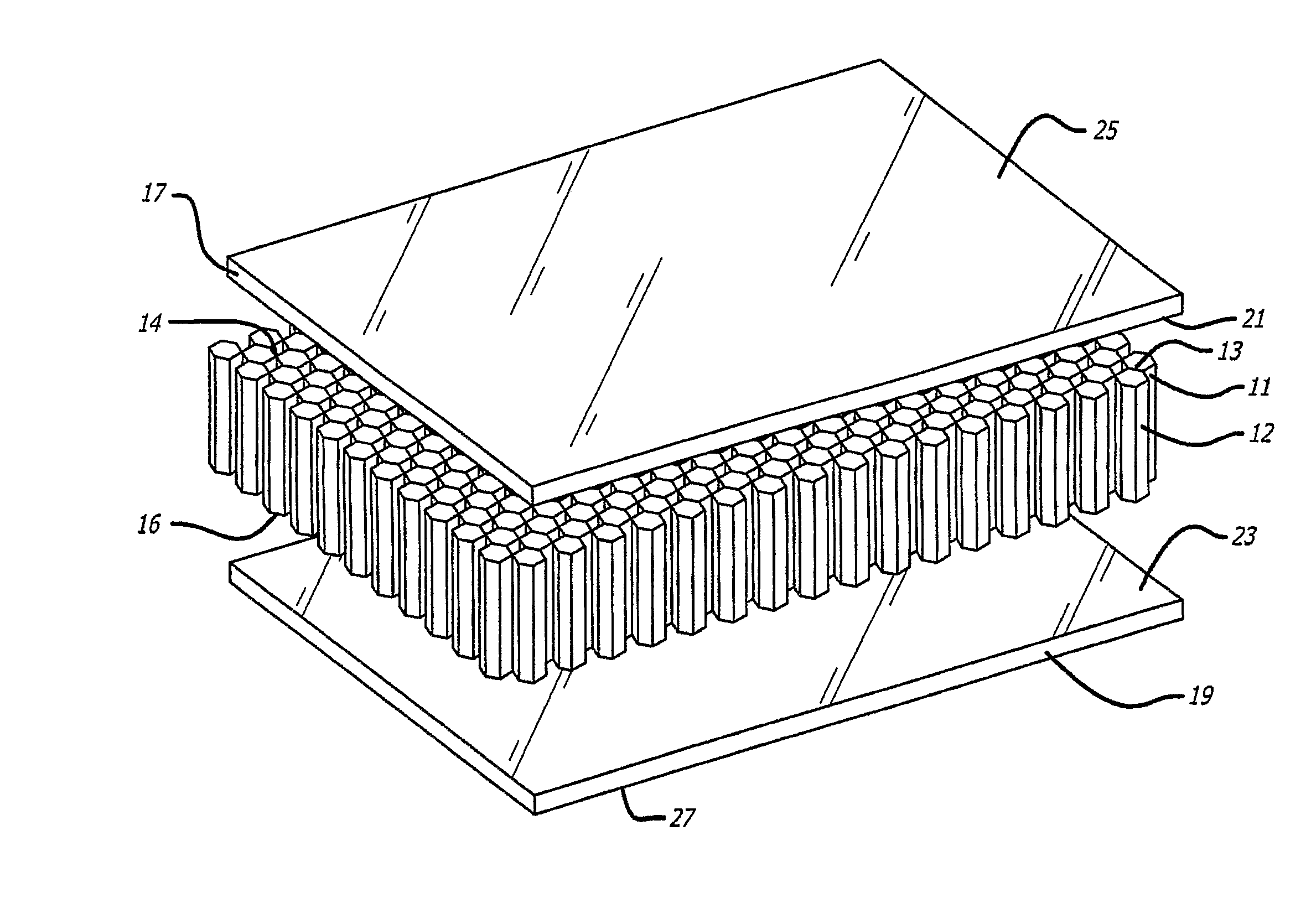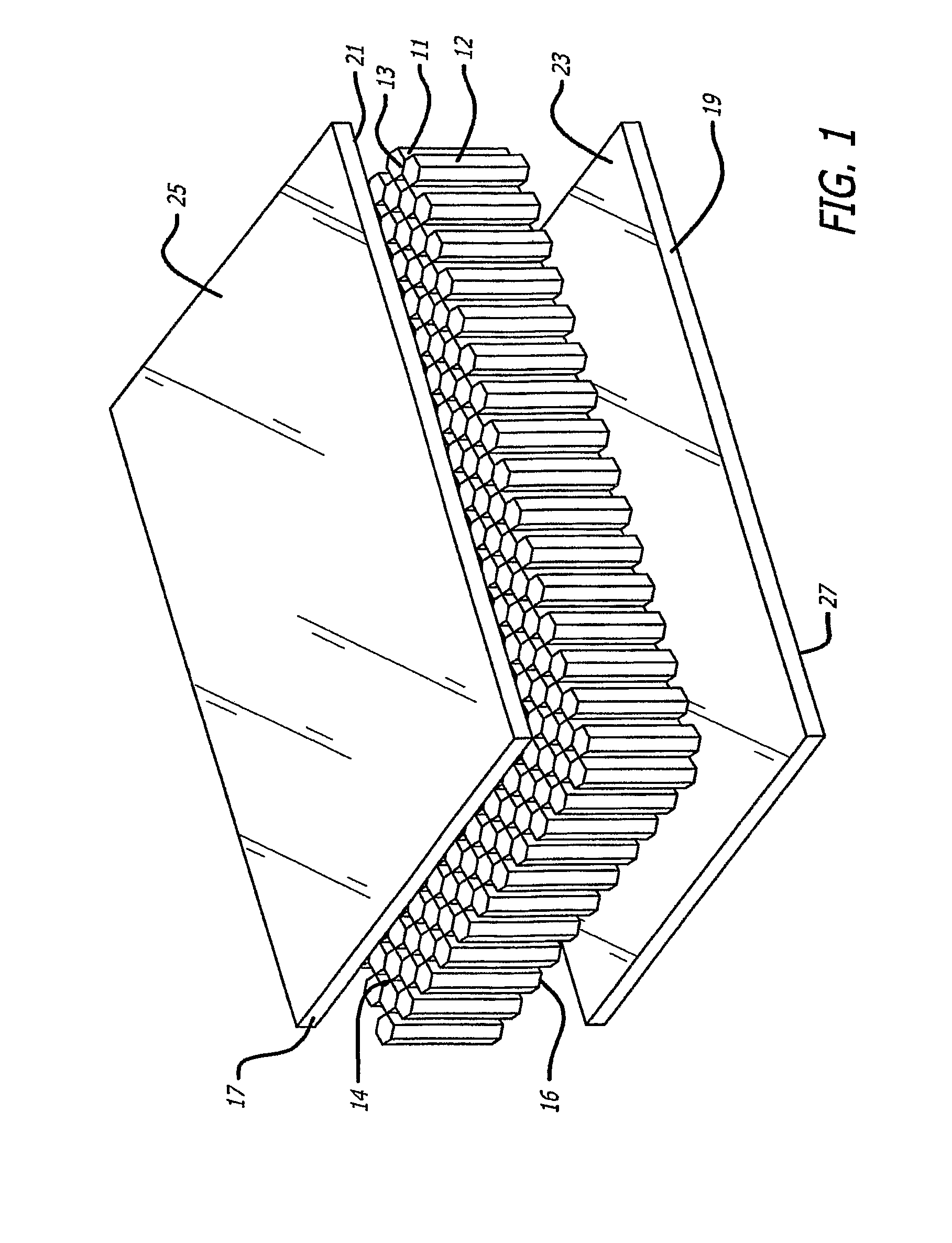Thermosetting resin adhesive containing irradiated thermoplastic toughening agent
a thermoplastic toughening agent and thermosetting resin technology, applied in the field of composite materials, can solve the problems of reducing the loss of adhesive properties that typically occur, measurable increase in the molecular weight of thermoplastic polymers, etc., and achieve the effect of reducing the level of solvent-induced micro crack formation
- Summary
- Abstract
- Description
- Claims
- Application Information
AI Technical Summary
Benefits of technology
Problems solved by technology
Method used
Image
Examples
example 11
Preparation of Irradiated Thermoplastic Toughening Agents
[0061]Seven exemplary irradiated thermoplastic toughening agents in accordance with the present invention were prepared as follows:
[0062]Six 1 kg samples of PES / PEES powder (Solvay Madel A105P SEP grade) were sealed separately inside polyethylene bags to give a final thickness of approximately 25 mm. The six bags were then sealed within flat cardboard cartons about 20 cm×30 cm. The cartons were exposed to electron beams at total levels of 64, 128 and 255 kGy and gamma radiation at levels of 51, 100 and 200 kGy. The boxes were turned over half way through the exposure to ensure good coverage of the powder by the beam. The resulting six powders were light yellow in color compared to the off-white color of the starting powders. The powder irradiated with 255 kGy was slightly more yellow than the powder irradiated with 64 kGy.
[0063]Four 1 kg sample of PES powder (Sumikaexcel 5003P) was also sealed inside polyethylene bags to give ...
example 2
Preparation and Testing of Resin Composition with Tri- and Tetra-Functional Epoxy
[0065]The following method was used to prepare exemplary uncured resin composition that contain tri-functional and tetra-functional epoxy resin in combination with the irradiated thermoplastic toughening agents prepared in Example 1.
[0066]737 g of the tetraglycidyl amine of methylenebisaniline (Araldite MY9512) and 654 g the triglycidyl derivative of p-aminophenol (MY0510) were added to a Winkworth mixer at room temperature and heating started. 442 g of irradiated PES / PEES or PES powder was added and mixed until dispersed. The mix was heated to 130° C. and mixed for 2 hours to dissolve the irradiated powder. The mix was cooled to 90° C. to 100° C. At this stage, 167 g of a 50 / 50 blend of MY0510 and dicyandiamide (Dyhard 100) was added and mixed until dispersed to provide the uncured resin composition. Seven different uncured resin compositions were prepared using the seven irradiated PES / PEES and PES po...
example 3
Mechanical Performance of Laminates Made Using Irradiated PES and PES / PEES
[0074]The benefits of the reduced micro-cracking arising from the use of irradiated PES and PES / PEES copolymers on mechanical performance was measured by the determination of the Interlaminar Shear Strength (ILSS) of cured composite laminates. The ILSS of the laminates made from untreated PES and PES / PEES as described in Comparative Example 1 and laminates made with e-beam treated PES and PES / PEES, as described in Example 1 were measured, according to the test method EN2563. One set of test samples had no exposure to MEK solvent, the second set were immersed in MEK solvent for 6 days prior to testing. The reduction in ILSS after the solvent exposure is a measure of the amount of micro cracking in the samples. The results of the tests are set forth in TABLE 3. These ILSS tests demonstrate the improvement of the mechanical performance after MEK solvent exposure of laminates made from resins and prepregs incorpor...
PUM
| Property | Measurement | Unit |
|---|---|---|
| wt % | aaaaa | aaaaa |
| particle sizes | aaaaa | aaaaa |
| thickness | aaaaa | aaaaa |
Abstract
Description
Claims
Application Information
 Login to View More
Login to View More - R&D
- Intellectual Property
- Life Sciences
- Materials
- Tech Scout
- Unparalleled Data Quality
- Higher Quality Content
- 60% Fewer Hallucinations
Browse by: Latest US Patents, China's latest patents, Technical Efficacy Thesaurus, Application Domain, Technology Topic, Popular Technical Reports.
© 2025 PatSnap. All rights reserved.Legal|Privacy policy|Modern Slavery Act Transparency Statement|Sitemap|About US| Contact US: help@patsnap.com


